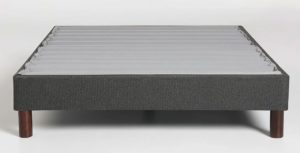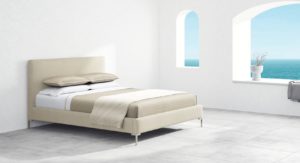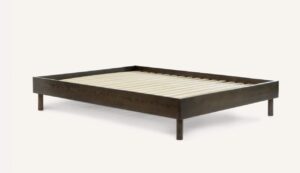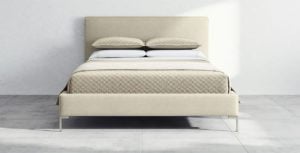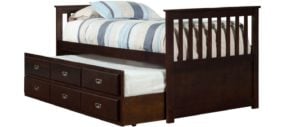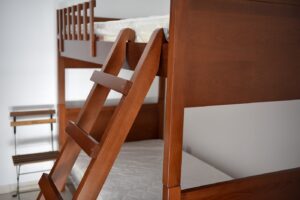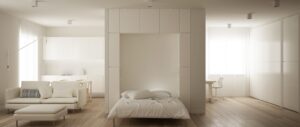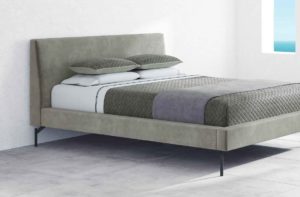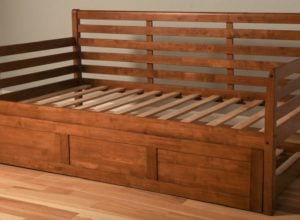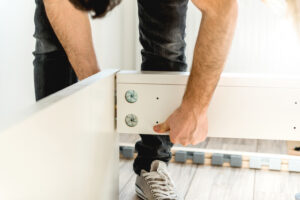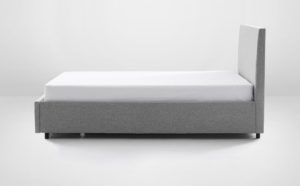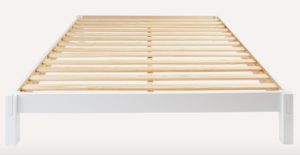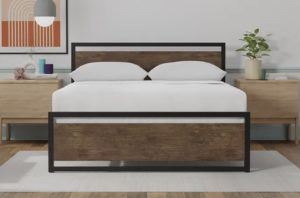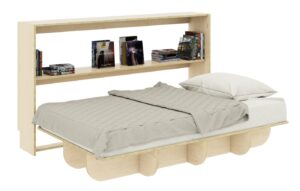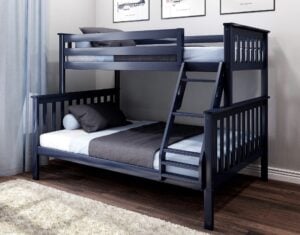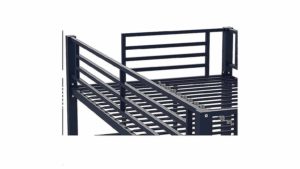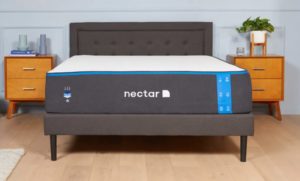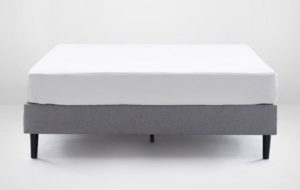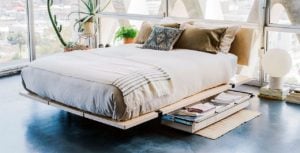Platform Bed Ideas
Setting up your bed is a central part of promoting healthy sleep. Most people know it’s critical to choose the best mattress based on their individual needs and preferences, but they may not put as much thought into their bed frame, which plays a role in mattress height, stability, and comfort.
Platform beds are one of the most popular types of bed frames. They can be designed with a wide range of materials, designs, and extra features. Numerous options are available to buy them online and in-store, or you can find abundant websites with ideas and plans for a DIY platform bed project.
Whether you’re looking to purchase a platform bed to install ASAP or want to build your own, you can find all the key information that you need to know in this detailed guide.
What is a Platform Bed?
A platform bed is a type of bed frame that is designed to provide a flat foundation that can support a mattress without the use of a box spring. Many platform frames offer an underbed storage space that is especially useful for people who live in small apartments.
Traditionally, the term platform bed was used to describe simple, minimalist bed frames, but today platform beds can include a far-ranging collection of styles, designs, and materials.
What Are the Components of a Platform Bed?
Several components are involved in the construction of a platform bed. Some of those components are required while others are optional.
There are two necessary components of a platform bed: the platform and the legs.
Platform
The platform is the part of the frame upon which the mattress goes. A reliable platform holds up the mattress and is what allows you to use a platform bed without a box spring.
There are several ways to build the platform:
| Platform Build | Material | Benefits | Downsides |
|---|---|---|---|
| Solid/Flat Material | Wood, plastic, metal, bunkie board | Consistent surface | Reduced ventilation; may be heavier |
| Slats | Wood, plastic, metal, bunkie board | Better ventilation; lighter weight | Less consistent support; slats must be held securely in place |
| Lattice / Grid | Usually metal | Fixed support structure; better ventilation | May be heavier |
Legs / Supports
In the design of these beds, the platform cannot sit flush against the ground, which means that it needs supports underneath it. The minimum amount of support is four legs with one at each corner of the frame.
In addition to those four legs, many platform beds have at least one additional leg for support in the center of the frame. The extra leg or legs in the center provide reinforcement for the platform so that it does not sag in the middle. These legs may also hold up a center support beam that runs from the head to the foot of the bed and underneath the platform.
Optional Components of a Platform Bed
In addition to the platform and supports, there are other optional components that can be built into a platform bed to enhance its functionality and aesthetics.
- Headboard: A headboard can add style to a platform bed. It can be either short or tall and may have either a rounded or rectangular form. If a bed is placed away from a wall, a headboard can keep pillows from falling off the bed.
- Footboard: Like a headboard, a footboard can add style and take on various designs.
- Drawers: While most platform beds include an open space underneath the platform, some styles incorporate drawers in this area, providing both visual appeal and storage.
- Canopy: A canopy can be added to a platform bed by extending vertical supports up from the corners and creating a rectangular frame above the bed over which a cloth material can be draped. Some people may refer to this as a canopy bed rather than a platform bed.
What Are the Types of Platform Beds?
There are multiple styles and types of platform beds; however, there is no standardized terminology for describing them. For that reason, it can be helpful to be aware of the various ways of categorizing platform beds and some of the terms that you may come across as you consider your platform bed options.
- 4 / 5 / 6 Legs: This way of categorizing platform beds focuses on the number of legs.
- Type of Platform: Another way of describing these beds is by the nature of the platform itself and whether it is solid, slatted, or made with a metal grid or lattice structure.
- Floating: A floating platform bed does not place the legs directly in the corners. Instead, the supports are further underneath the platform and partially obscured, making the platform appear as if it is floating or hovering off the ground.
- Low-Rise or High-Rise: This categorization focuses on whether the platform is close to the ground or if there is more ample space between the platform and floor.
- Storage Platform Bed: In this type of platform bed, one or more drawers are included as part of the frame underneath the platform.
What Materials Can Be Used to Make a Platform Bed?
A platform bed can be built with several different kinds of materials. In most cases, only one or two types of materials are used in any individual platform bed.
Wood
Wood is one of the most popular materials for these frames. When made with high-quality wood, a platform bed can generate a stable, heavy-duty feel. Wood also offers a range of styles based on the type of wood and choice of stain.
Because of its availability and ease of use in home projects, wood, including reclaimed wood, is a top choice for DIY platform beds. Even when the frame is built with other material, slats for a platform bed may be made of wood. The primary downside to wood is that it can be heavy, making a platform bed more difficult to move.
Metal
Metal is commonly used in all types of bed frames, including platform beds. The thickness of the metal influences the strength of the platform bed as well as its overall weight.
Most metal platform beds have a minimalist look, often with sleeker supports built out of black or silver metal. These may use metal slats, wood slats, or a grid of metal supports that serve as the platform for the mattress.
Creating joints or connections between different metal pieces can be more complicated to do at home, which is why metal is more often used in store-bought platform beds than those that are DIY.
Plastics and Composite Materials
Though less common, plastics and composite materials (formed through the combination of two or more distinct material inputs) can be used to make platform beds. While lightweight, these materials may not offer the same robust support as wood or metal. In most cases, they also have less aesthetic appeal. That said, repurposed plastics or composites may be useful in creating a low-cost, DIY platform bed.
Bunkie Boards
A bunkie board, also spelled bunky board, is a pre-made platform piece. It can be one solid piece or slatted and may be composed of wood, metal, plastic, or composite materials. Bunkie boards can serve as a low-cost and easy-to-use option for creating the platform layer on which to place a mattress on a platform bed.
Reused Materials
Various types of recycled or reused materials can be employed by creative and resourceful DIY builders of platform beds. By far the most prominent example of repurposed material in a platform bed is old wood pallets. Other examples include cinder blocks and unused or lightly used particle board.
How Can You Build Your Own Platform Bed?
If you want to build your own platform bed, the first step is to get inspired. A wealth of sites online and social media can provide platform bed ideas. Reading about other peoples’ experiences and seeing their photos can provide ideas for overall feel, style, headboards, footboards, and other features. They can also offer ideas for saving money and building a DIY platform bed on a budget.
The second step is to form a detailed plan. Some sites even offer free construction plans and diagrams. If you want to craft your own, make sure to draw it out with special attention paid to the measurements and how the different pieces will be connected and supported.
The third step is to acquire all of the materials that you need in order to build the bed. Make sure that you have space to work with these materials and the tools you need to do so safely.
Once you have your materials, tools, and workspace ready, you can get started on the fourth step, which is actually building the platform bed. Follow the plan and diagrams you created to ensure the structural integrity of your platform bed.
The fifth step is to move the platform bed into the preferred position in your bedroom and then carefully place the mattress on it. Check to make sure that the bed feels stable and comfortable, and make any necessary adjustments or reinforcements.
What Special Considerations Are There for a DIY Platform Bed?
If you’re putting together your ideas and plans for a DIY platform bed, don’t get too far along without making sure to take some of the following considerations into account:
- The mattress warranty: If your mattress is still under warranty, that warranty may only remain valid if the mattress is used on a bed frame that meets certain characteristics. For example, the warranty may stipulate a certain type of frame or distance between slats. Check the fine print of the mattress warranty to make sure you’re properly supporting the mattress both to promote its durability and to maintain the validity of the warranty.
- Mattress weight and use: Some mattresses are much heavier than others and can require a more heavy-duty platform bed. In addition, if the bed is for children (who may jump on the bed), people over 230 pounds, or couples (who may put more strain on the bed during sex), the frame may need to be reinforced.
- Mattress dimensions: Double-check the dimensions of your mattress to be sure that it will fit the design that you plan to use and will provide your preferred height for the bed as a whole.
- Check your tools: Before getting started on any project, you want to know that you have the right tools for the job. As part of your construction planning, make a list of all materials and tools that you need and confirm that you have those at your disposal.
Where Can You Buy a Platform Bed?
Platform beds are widely available for purchase online. Customers have an extensive selection of brands and models to choose from that reflect the diversity of materials and styles used to build platform beds.
One place to buy a platform bed is directly from a manufacturer. Many mattress manufacturers offer their own bed frames that can be purchased from them without an intermediary. Direct sales can mean lower prices, especially if a platform bed is part of a bundle with a new mattress and/or other bedding.
| Mattress Manufacturer/Brand | Platform Bed | Platform Bed Material | Mattress Options |
|---|---|---|---|
| Tuft & Needle | Wood Bed Frame | Wood | Tuft & Needle Original Tuft & Needle Mint Tuft & Needle Hybrid |
| Saatva | Santorini Bed Frame | Wood with velvet upholstery | Saatva Classic Saatva HD Loom & Leaf Zenhaven Saatva Solaire |
| Casper | The Casper Platform Bed Frame & Base | Aluminum with wood slats | Casper Original Casper Hybrid Casper Wave Casper Wave Hybrid Casper Essential |
| Purple | The Purple Platform Bed Frame | Steel | Purple Original Purple Hybrid Purple Hybrid Premier |
| Leesa | The Leesa Platform Bed | Wood frame and slats, twill fabric finish | Leesa Original Leesa Hybrid Leesa Legend |
All of these options are available for purchase online. In addition, platform beds are sold online by third-party retailers, including Amazon, which offers a range of models with different styles and price points.
For people who want to shop in a brick-and-mortar store, mattress showrooms, furniture stores, and department stores are all likely to carry bed frames including one or more options for a platform bed.
How Much Does a Platform Bed Cost?
The price of a platform bed depends on how it is built and the size of the frame that you need. The simplest platform beds may be available for around $100 or even less when on sale. More elaborate or heavy-duty platform beds can cost $1,000 or more.
Should I Buy or Build My Own Platform Bed?
If you’ve decided that you want a platform bed but are on the fence about whether to buy one or build one, these factors may help you decide.
You should lean toward buying a platform bed if:
- You have limited experience with DIY projects. Since it needs to support the weight of your mattress and body, a platform bed may not be the ideal starter DIY project.
- You put heavy strain on the bed. If you’re reliant on a sturdy bed base because of your weight or how you use your mattress, it may be wiser to opt for a proven, well-reviewed platform bed.
- You want to ensure the validity of your mattress warranty. You can typically be more confident that your mattress warranty will remain valid if you select an appropriate platform bed to buy as opposed to making one yourself.
- You lack tools or workspace. If you have to acquire new tools or occupy your living room as a workshop to try to build a platform frame, it likely makes more sense to purchase one instead.
- You need a bed frame ASAP. Most platform beds bought online can be quickly delivered and installed with ease, so if you’re in a rush, it’s better to buy a platform bed than build one.
You should lean toward building your own platform bed if:
- You’re handy and have experience with DIY projects. If you’re comfortable building furniture, you are likely to have an easier time doing the planning and actual building of a platform bed.
- You already own the necessary tools. If you already have the tools you need, you can get to work more quickly and reduce added costs associated with buying or renting them.
- You have access to materials. If you know what materials you want and can get them without too much cost or inconvenience, it’s a strong argument for a DIY approach.
- You want a customized design. If you have ideas for platform bed storage or a specific headboard, footboard, or other stylistic element, you have far more control if you build the platform bed yourself.
- You’re on a tight budget. While your options will be more limited with a tight budget, you can likely use discarded or repurposed materials to put together a usable platform bed for cheap.

Still have questions? Ask our community!
Join our Sleep Care Community — a trusted hub of sleep health professionals, product specialists, and people just like you. Whether you need expert sleep advice for your insomnia or you’re searching for the perfect mattress, we’ve got you covered. Get personalized guidance from the experts who know sleep best.

